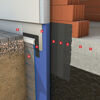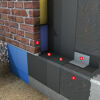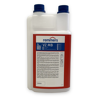Base seals are usually made with mineral water proofing grouts; however, there is a distinct downside: They only adhere to mineral surfaces. This means that they need to be applied to new buildings before the bitumen-based waterproofing that has contact with the ground. This is not the case with the new MB 2K: It combines the properties of crack-bridging, mineral water proofing grouts and polymer modified, bituminous thick coating in one product.

Splashwater & ground moisture in the wall base (W4-E)
The water impact class W4-E, which was specially developed for the base area, defines the effect of the capillary water in and under the walls and also the splashwater and ground moisture on the wall base. The new version of the norm states that only compliant crack-bridging MDS may be used as base seal for this area.
These systems have proven their worth in practice, but they do have a decisive disadvantage: They only adhere to mineral surfaces.
This is not the case with MB 2K: The adhesive capability of the material is so good that it adheres to all conventional building surfaces, even to bitumen water proofing. This opens up completely new applications. There are hardly any adhesion-relevant restrictions; transition areas in the base can be easily water proofed.
Proof:
- AbP pursuant PG MDS
- Adhesive strength of MB 2K on bitumen
Cross-interface plinth seal
It is almost always necessary to change material when water proofing the transition at the base of the building with fluid sealing materials. This work is carried out in a conventional method so that the base zone is sealed with a mineralogical substance and the area that has contact with the ground is sealed with
bitumen. The transition from the mineral to the bitumen system on the base represents a material-related weakness. This is where the special technology of MB 2K comes into its own. MB 2K shows optimum adhesion on mineral and bitumen-based surfaces, and can therefore also be applied to bitumen. In this way, transition areas can be waterproofed in line with new normative specifications so that water cannot run behind.
1 Preliminary work
Remove the adhesion-inhibiting components.
2 Primer
Apply Kiesol MB evenly. Pre-wet heavily absorbent subsurfaces with water. Leave out equalised
areas.
3 Scratch coat
Apply a scratch coat made of MB 2K on the existing PMBC and the mineral subsurface
(overlap > 100 mm).
4 First water proofing layer
Apply the first water proofing layer made of MB 2K evenly.

Waterproofing below the face masonry layer
To date there are no clear rules for the use of fluid sealing materials like PMBCs or crack-bridging MWG for base water proofing on two-leaf cavity masonry. When the new national regulations come into force, the above-mentioned product systems that have proven their worth for many years will be included in the standard. The flexible polymer-modified thick coating Remmers MB 2K can also make its mark in this area thanks to its unique performance. MB 2K not only fulfils the specifications for crack-bridging MWG (PG MWG), but also the 3-fold pressure resistance stipulated for the PMBCs. MB 2K is also very easy to process and can be applied both in a grouting or filling procedure. In conjunction with the fleece-laminated joint bands of the VF series, this system solution is very easy to produce, it is also practical and has been compliant with the norm since July 2017.
Proof:
- AbP pursuant PG MDS
- Review of deformation under 3-fold norm load (from DIN EN 15814)
1 Preliminary work
Chamfer the edge of the wall positioning area. Remove the adhesion-inhibiting components.
2 Priming
Apply Kiesol MB evenly. Pre-wet heavily absorbent subsurfaces with water.
3 Scratch coat
Apply the scratch coat made of MB 2K.
4 Install joint band
Apply MB 2K near the inside corner and embed the joint band VF using a wet-in-wet method.
5 First water proofing layer
Apply the first water proofing layer made of MB 2K evenly.
6 Second water proofing layer
Apply the second water proofing layer made of MB 2K as soon as the first coat can no longer be damaged.
7 Masonry work course
Brick up the water proofing after the above ground wall has dried adequately.

Base waterproofing
10 products foundView:
Article No. 507101
High-quality, premium sealing tape based on nitrile rubber and coated with non-woven fabric
Article No. 500301
Highly elastic, self-adhesive butyl rubber waterproofing tape on polypropylene non-woven fabric
Article No. 480201
High-grade premium sealing tape made from nitrile rubber with double-sided non-woven coating
Article No. 480301
High-quality premium sealing tape with a non-woven coating on an NBR base with 30 mm self-adhesive strips





![WP DS [basic] WP DS [basic]](https://m.remmers.com/gebindeabbildungen/2400w/32182.png?version=0&w=100)

![WP DKS rapid [basic] WP DKS rapid [basic]](https://m.remmers.com/gebindeabbildungen/2400w/81238.png?version=0&w=100)


